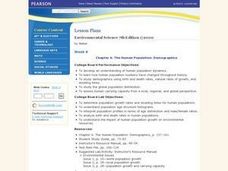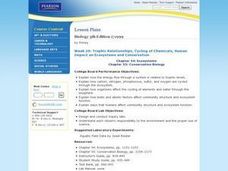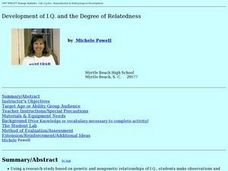Curated OER
Life Cycle of the Drosophila Fly
Students observe the life cycle of the Drosophila fly as well as manipulate large numbers of flies, determine the difference between the sexes, and identify the different stages of the fly's life cycle.
Curated OER
Natural Resources: Getting a Fair Share?
Students explore the impact of human behavior on key components of the environment, examine how theirn own personal decisions have added to the problem, and explore possible solutions to the current ecological crisis.
Curated OER
Chapter 6: The Human Population: Demographics
Students read the indicated text and complete several suggested labs and activities. They answer critical thinking questions. This lesson is very hard to do without the indicated text.
Curated OER
Trophic Relationships, Cycling of Chemicals, Human Impact on Ecosystems and Conservation
Learners explore how the energy flow through a system is related to trophic levels. They investigate how organisms affect the cycling of elements and water through the biosphere. Students participate in lab activities to observe ways...
Curated OER
Enzyme Lab
High schoolers examine the effects of specific enzymes on samples of liver tissue, muscle tissue (chicken), apples, and potatoes.
Curated OER
Using My Nasa Data To Determine Volcanic Activity
Students use NASA satellite data of optical depth as a tool to determine volcanic activity on Reunion Island during 2000-2001. They access the data and utilize Excel to create a graph that has optical depth as a function of time for the...
Curated OER
Sea Surface Temperature Trends of the Gulf Stream
Students explore the importance of the Gulf Stream. Using a NASA satellite images, they examine the sea surface temperature. Students collect the temperature at various locations and times. Using spreadsheet technology, they graph the...
Population Connection
Where Do We Grow from Here?
Did you know that the population is expected to grow to 11 billion by 2100? The resource serves final installment in a six-part series on the global population and its effects. Scholars interpret data from the United Nations about the...
Population Connection
The Peopling of Our Planet
How many people live on the planet, anyway? The first resource in a six-part series covers the topic of the world population. Scholars work in groups to conduct research and make population posters after learning about the global...
Population Connection
A Demographically Divided World
Did you know that birth and life rates vary across the world? The resource, the second in a six-part series, discusses just how demographics differ across countries and why it might be the case. Scholars complete worksheets, watch...
Kenan Fellows
Using Water Chemistry as an Indicator of Stream Health
Will this water source support life? Small groups test the chemistry of the water drawn from two different sources. They then compare the collected data to acceptable levels to draw conclusions about the health of the source. The...
Kenan Fellows
Effects of a Golf Course on Stream Health
Is the golf course causing issues in the stream? Find out with a resource that has groups perform chemical water tests to analyze the effects of a golf course on a stream. Pupils collect water above and below the course and analyze the...
Curated OER
Molecular Evolution in Plants
Students are using a paper chromatography study that is suitable for introductory biology. The absorption spectra studies and gel electrophoresis studies are appropriate for students who have complete both introductory biology and...
Curated OER
Development of I.Q. and the Degree of Relatedness
Studnets, in groups, analyze data regarding genetic and nongenetic relationships of I.Q. They make observations and discuss correlations from a diagram. Cooperative learning teams discuss a given set of questions and present information...
Curated OER
Molecular Evolution in Plants
Students examine chlorophylls. They explore the absorbing pigments in a variety of plants. Through activities, students determine spectrophotometrically. They compare plant proteins from the family Brassicace to assess the level of...
Population Connection
The Human-Made Landscape
Agriculture, deforestation, and urbanization. How have human's changed the planet and how might we mitigate the effects of human activity on the planet? To answer these questions class members research the changes in human land use from...
Curated OER
Trouble in the Troposphere
Students Use data sets from MY NASA DATA to produce graphs comparing monthly and yearly ozone averages of several U.S. cities. They analyze and evaluate the data and predict trends based on the data. In addition, they discuss and...
Curated OER
Examining the Ties Between Abolitionism and the Women's Rights Movement
Students examine the historical link between the abolition and women's movements. After a brief introduction and mini-lecture, students work in pairs or small groups to complete a web quest to answer instructor provided questions...
Georgia Department of Education
Ga Virtual Learning: Ap Environmental Science:ap Environmental Science Exam Prep
Students can use this complete review as a study guide and practice before taking the College Board AP Environmental Science Course Exam.
Georgia Department of Education
Ga Virtual Learning: Ap Environmental Science: Course Introduction
An introduction to Environmental Science, an interdisciplinary field of study that integrates the biological and physical sciences in an effort to understand environmental systems, and the solutions to both man-made and natural...
Georgia Department of Education
Ga Virtual Learning: Ap Environmental Science: Introduction
An introductory module with interactive activities, class notes, lab activities, and review questions which cover advanced placement environmental science concepts.
Georgia Department of Education
Ga Virtual Learning: Ap Environmental Science: Terrestrial Biomes and Land Use
How we can live sustainably on our natural resources while also preserving enough nature so these resources can be replenished represents one of the most important questions in environmental science. Through learning about terrestrial...
Georgia Department of Education
Ga Virtual Learning: Ap Environmental Science: Toxicology and Human Health
Students investigate hazards to human health that are found where we live, work, and play, and begin to understand the risk analysis and system of evaluation that was developed to protect us from potential environmental dangers.
Georgia Department of Education
Ga Virtual Learning: Ap Environmental Science: Energy Use and Energy Sources
This interactive learning module will focus on the fundamentals of energy and energy sources, renewable and nonrenewable, that support the human population. Students will also explore our dependence on nonrenewable fossil fuels to...

























